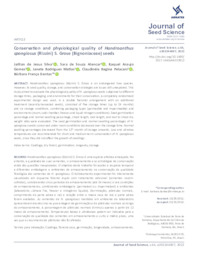Conservation and physiological quality of Handroanthus spongiosus (Rizzini) S. Grose (Bignoniaceae) seeds.
Conservation and physiological quality of Handroanthus spongiosus (Rizzini) S. Grose (Bignoniaceae) seeds.
Author(s): SILVA, J. de J.; ALENCAR, S. de S.; GOMES, R. A.; MATIAS, J. R.; PELACANI, C. R.; DANTAS, B. F.
Summary: Handroanthus spongiosus (Rizzini) S. Grose is an endangered tree species. However, its seed quality, storage, and conservation strategies are issues still unexplored. This study aimed to evaluate the physiological quality of H. spongiosus seeds subjected to different storage times, packaging, and environments for their conservation. A completely randomized experimental design was used, in a double factorial arrangement with an additional treatment (recently-harvested seeds), consisted of five storage times (up to 24 months) and six storage conditions, combining packaging types (permeable and impermeable) and environments (room, cold chamber, freezer, and liquid nitrogen conditions). Seed germination percentage and normal seedling percentage, shoot length, root length, and root to shoot dry weight ratio were evaluated. The seed germination and normal seedling percentages of H. spongiosus seeds conserved under room conditions decreased over the storage time. Normal seedling percentages decreased from the 12th month of storage onwards. Low and ultralow temperatures are recommended for short and medium-term conservation of H. spongiosus seeds, since they did not affect the growth of seedlings.
Publication year: 2022
Types of publication: Journal article
Unit: Embrapa Semi-arid Region
Observation
Some of Embrapa's publications are published as ePub files. To read them, use or download one of the following free software options to your computer or mobile device. Android: Google Play Books; IOS: iBooks; Windows and Linux: Calibre.
Access other publications
Access the Agricultural Research Database (BDPA) to consult Embrapa's full library collection and records.
Visit Embrapa Bookstore to purchase books and other publications sold by Embrapa.

